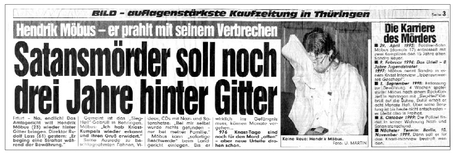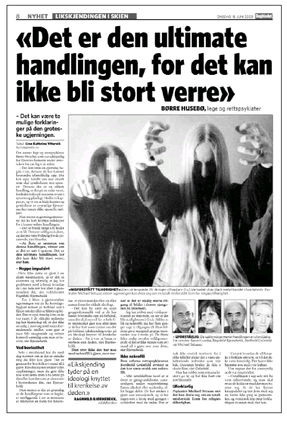PREFACE TO THE NEW EDITION
LORDS OF CHAOS WAS RESEARCHED AND WRITTEN IN THE YEARS 1994–97 and published in 1998. It became a subcultural sensation almost immediately. Somewhat to our surprise, it caught the interest of an astonishingly wide range of readers. The book has been hailed as a revelation by both underground fan and ivory tower academic alike. Many people who would otherwise have zero interest in a topic like Black Metal have been fascinated to gaze into this otherwise hidden underworld. Well-dressed businessmen were spotted reading it on the London Underground.
The attention did not stop there. At the American national publishing convention, it won the coveted independent press Firecracker Award for “Best Music Book” of the year. We were widely interviewed by the mainstream media both in Europe and across America, appearing in magazine articles, television documentaries, and radio programs which ran the gamut from Howard Stern to Christian talk shows. It was not long before we became de facto experts on the modern phenomenon of “unexplained youth violence.” The day of the infamous Columbine school shootings, a major radio news program had us on to provide live, real-time commentary as part of their effort to help listeners understand the real motivations behind such a seemingly senseless, brutal event.
Earlier this year, a long-awaited German edition of Lords of Chaos appeared, accompanied by a double-CD compilation of music which provided the soundtrack to the book’s contents. In a major press blitz, both releases were widely reviewed across Europe; full-page pieces on the history of Black Metal appeared in the strangest of places, from daily papers to the Financial Times, the German equivalent of the Wall Street Journal. When the anniversary of Germany’s own bloody school shooting at Erfurt came around, our comments wound up in newspaper editorials on the subject.
In essence, this is a radical book. Radical in the true sense of the word (deriving from the Latin radix, “root”), it explores the roots of the matter at hand in an unflinching fashion. It is not our job to pass judgment on our subjects; we expect the readers to have the intelligence to do that for themselves. This reluctance to overtly criticize those whom we interview and document has occasionally been a source of consternation for reviewers who harbor their own moralistic agendas, who claim that by neglecting to “properly”—read: politically correctly—interpret this material for the reader, we are allowing potentially dangerous ideas a free voice. In a sense, they may be right. Our world, increasingly homogenized and with the entire spectrum of its cultural creations adulterated for palatable mass-consumption, needs dangerous ideas more than ever. It may not need the often ill-formed and destructive ideas expressed by some of the protagonists in Lords of Chaos, but we felt all along that this is an issue for the individual reader to decide.
However, at times we simply couldn’t resist commenting on our subjects’ views. Case in point: the claim (made by Varg Vikernes and some of his fellow travelers) that Norway is run by a Jewish conspiracy. The notion of a “Protocols of the Elders of Zion”-style Jewish cabal running the world is absurd to begin with, but all the more so in a country with practically no Jewish population, and we felt the need to point this out. In many instances, the reader will also find that the outrageous points being made by one person are soon commented upon and put into a different light by other interview subjects.
We do not claim to offer any cut-and-dried rationale for why these events all happened, or continue to happen. There is no simple or single answer. While a certain amount of what is found in these pages can be ascribed to age-old impulses of teenage rebellion, undoubtedly there was and is something deeper going on, a certain energy twisting and erupting from below the ground—something from the roots.
A few critics have accused us of overemphasizing the extreme political rhetoric that marks some quarters of the Black Metal scene. The implication is that we did so for sinister reasons. An example is Hendrik Möbus of the German band Absurd (whose exploits are detailed in chapter 11). Möbus was an obvious focal point for us since, in many respects, this volume became a true crime book. But the effects of Lords of Chaos can also clearly be seen here. In the interview he granted to us for the first edition, Möbus made numerous extreme statements and the accusation was leveled at us on more than one occasion that we had unwisely given a obscure and insignificant figure a platform to express extremist political views. As things turned out, many of Möbus’s remarks were ultimately used against him as evidence during subsequent legal proceedings that resulted in an additional sentence he received for publicly deriding the victim of his crime. This was not the end of the matter. In order to avoid being sent back to prison, Möbus fled the country. He flew to the U.S., eventually finding safehousing with Dr. William Pierce, author of the notorious Turner Diaries and the director of the National Alliance, which is widely considered the most serious and “potentially dangerous” racialist organization in the country. It was not long before Möbus was apprehended by U.S. authorities and ultimately extradited to Germany. The obscure, insignificant figure had now reached the status of a notorious international fugitive, commanding headlines in major papers. These events demonstrate that our attention was warranted.

GERMAN HEADLINE AFTER MÖBUS VIOLATES PAROLE, PRIOR TO BECOMING AN INTERNATIONAL FUGITIVE: “SATAN MURDERER TO GET THREE YEARS BEHIND BARS”
NORWEGIAN HEADLINE: “IT’S THE ULTIMATE ACT, BECAUSE IT CAN’T GET MUCH WORSE”
There is no question that things have quieted down a bit in the Black Metal scene—at least insofar as its extra-musical activities go. The popularity of the music seems undiminished; indeed it has become a serious cash cow for the Norwegian music industry, and underground music in general. The major groups sell impressive quantities of records and draw multitudes of fans on their extensive worldwide tours. The Satyricon single “Fuel for Hatred” received heavy air-play on one of Norway’s three biggest radio stations, and just before this revised edition went to press we heard that Dimmu Borgir’s new album will be hawked to the public through TV advertising spots. Today most of the genre’s protagonists hold no interest in committing crimes. Fully aware they have a viable commercial and artistic product to sell, they take their musical careers seriously. For all the morbid cachet it might provide one’s reputation among the demi-monde, being locked up in a jail cell does not facilitate recording and playing music—in other words, making a living.
Nevertheless, recent events in Finland and Norway bear witness to the fact that Black Metal can still inspire fear and apprehension. Among the new sections in this revised edition is a chronicle of the particularly lurid crimes committed near Helsinki by Black Metal youths, news of which was heavily suppressed by the authorities for fear of copycat incidents.
And more recently in June 2003, Black Metal was back on the front pages in Norway. A 26-year-old man with a past as a member of a relatively unknown Black Metal band had been arrested in a case that was guaranteed to capture the nation’s imagination. Along with some younger compatriots, the former bass player had broken into a chapel where bodies were awaiting cremation. The group opened coffins and abused the deceased by cutting, beating, and stomping on the bodies; this was supplemented with a thorough vandalism of the chapel itself. The corpse of an older man was decapitated, and the severed head brought to a party for show-and-tell. The grotesque conversation piece was later retrieved from the basement of a young man who was totally unaware it had been deposited there.
The results were predictable: the case dominated the media for days, and even seemed to overshadow murders of living people and important world events. In a fit of hysteria the tabloids went into full gear, speculating upon whether the desecrations were part of Satanic rituals. Some urged that Black Metal music should be outlawed.
As might be expected, several key points were overlooked in the coverage of the case. In fact, the culprit wasn’t even really part of the Black Metal scene. He had long since been fired from his band for musical reasons, and was furthermore such a misfit that he had been more or less ostracized from the scene in general. His extensive abuse of drugs like ecstasy and GHB probably hadn’t helped his sorry situation. It is more likely that the prime contributing factors behind his extreme behavior were psychological and pharmacological rather than anything to do with music or Satanism.
But one thing had changed in the decade since Black Metal first shocked Norway. Since those early outrages it has become a both critically acclaimed and commercially appealing genre of music—the upshot of this being that the subculture now has mainstream media people ready to defend it. “Nobody in this scene would gain in status from chopping the head off a corpse,” claimed a prominent radio DJ who plays a lot of Black Metal. While this might make a good interview soundbite, it is no more true than tabloid rantings that paint all metal fans as potential corpse violators.
A significant degree of Black Metal’s allure and stature does not derive from the accomplished musical achievements and originality of the artists playing the music. The grisly crimes have contributed as much, and maybe even more, to its appeal. And while most Black Metal people are law-abiding citizens, they can hardly claim that the criminal element merely represents a clique of confused hangers-on. Those responsible for the murders, church burnings, and so forth have often been the prime movers and shakers of the scene. Underscoring this is the fact that key Black Metal magazines publish articles that treat real killers as cozy celebrities, or proclaim them to be outright heroes.
This new edition of Lords of Chaos has been revised in various places throughout, with corrections made, sections updated, and new material, interviews, and illustrations added. The format and the majority of the text from the original edition have been retained, for we feel they capture well the wild world of Black Metal—not to mention what is undoubtedly the strangest saga ever told in the history of popular music. Here blood, fire, and music were the volatile ingredients that fueled an alchemical explosion which still continues to loudly reverberate through the apocalypse culture of the modern world.
—MICHAEL MOYNIHAN AND DIDRIK SØDERLIND
LOS ANGELES AND OSLO, JULY 2003



